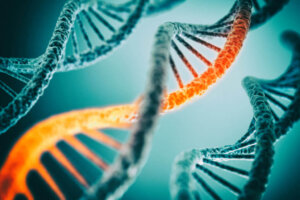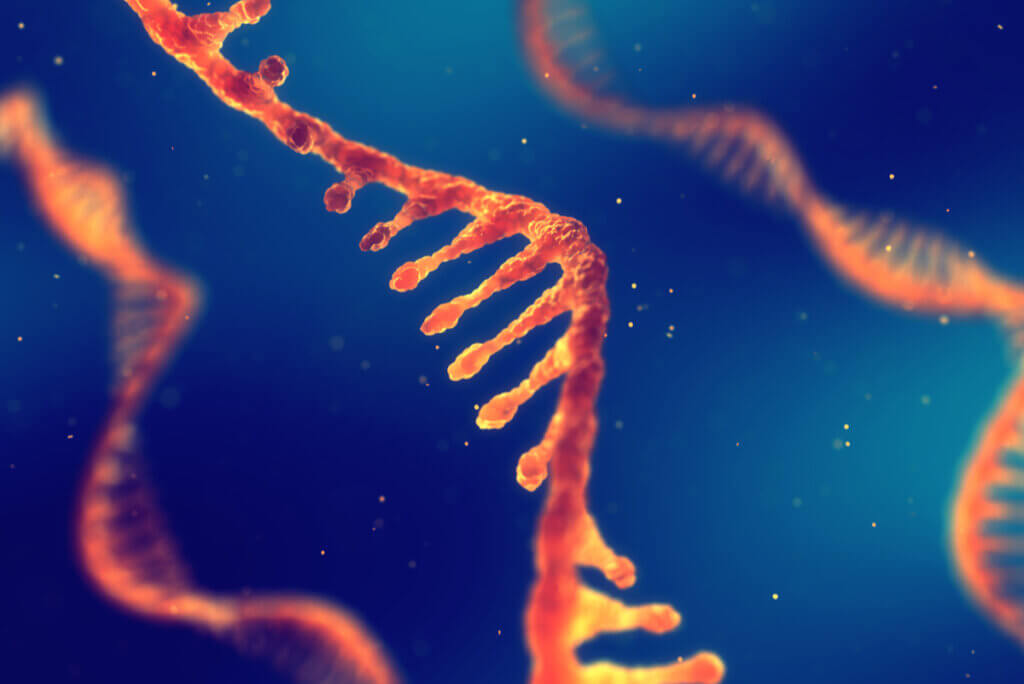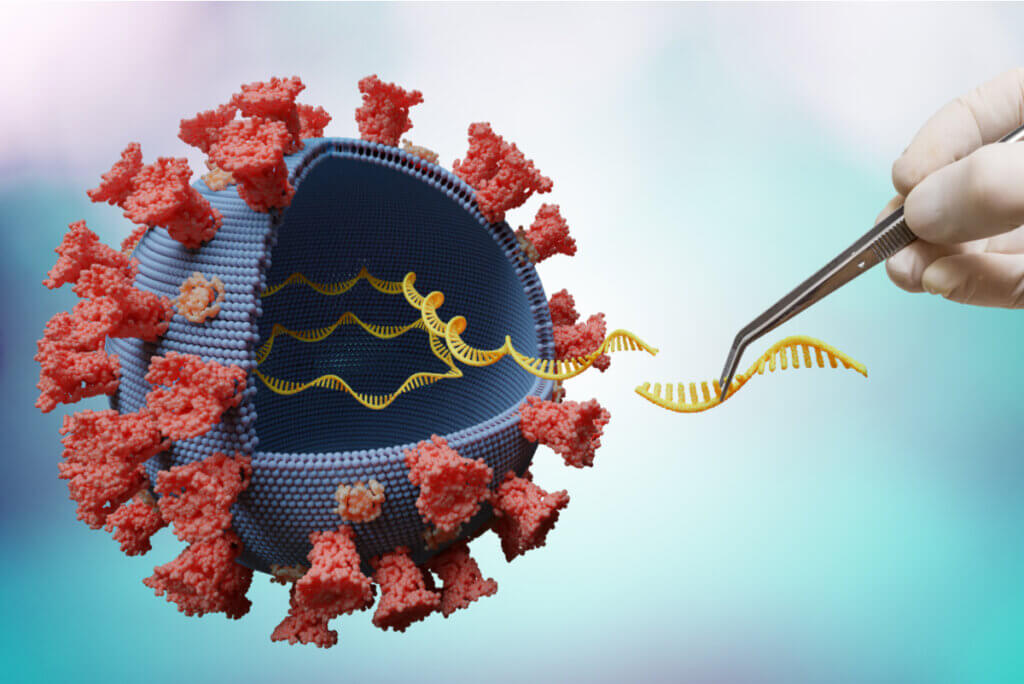The Differences Between DNA and RNA

Nucleic acids are basic molecules that are included in the structure of all living things. They form the basis of life and are determining factors such as heredity. These molecules are DNA and RNA. But what are the differences between them?
The function of nucleic acids is fundamental in all living organisms. They contain the genetic information necessary for the proper functioning of cells. Therefore, these structures are also used by microorganisms such as bacteria and by viral particles.
Both acids are made up of a chemical functional unit called a nucleotide. It has a very similar structure in both cases, with a phosphate group, a nitrogenous base, and a specific pentose.
What is DNA?
Before mentioning the differences between DNA and RNA, it’s important to have a clear concept of both structures. Deoxyribonucleic acid (DNA) is a double helix molecule found within the nucleus of all cells in the human body.
The main function of DNA is to serve as a source or repertoire of information, as it contains the entire human genome, thus establishing the main differences between individuals.
The nitrogenous bases used by the nucleotides that make up DNA are thymine, adenine, guanine, and cytosine. While the carbohydrate of 5 carbon molecules or pentose used will be deoxyribose.
What is RNA?
On the other hand, we have ribonucleic acid (RNA), a simple chain structure that can be found in various parts of the cell. Currently, three types of RNA (messenger, transfer, and ribosomal) have been described, each with a specific function within metabolism.
In general terms, the main action of the different types of RNA is protein synthesis. While some carry the information and amino acids necessary for the process, others interpret it and stimulate the synthesis itself.
The structure of RNA nucleotides is different from that of DNA; the nitrogenous bases, in this case, are guanine, cytosine, adenine, and uracil. For its part, the pentose used will be ribose, which is a more unstable molecule than DNA.

The differences between DNA and RNA
When reading the given concepts of DNA and RNA, it’s possible to notice that the biggest difference between both molecules is found in their structure. The first is composed of two different helices that combine with each other giving it the characteristic shape, while the second is a linear single-chain molecule.
The nitrogenous base thymine is replaced by uracil in RNA, this being a key difference in protein synthesis. Also, DNA is more stable and has a higher molecular weight than RNA. This occurs because of the pentose deoxyribose in its structure instead of the ribose molecule.
The location of DNA and RNA inside the cell is another key difference between the two molecules, as their function will depend on it. In this regard, DNA can only be found in the nucleus and in a microorganelle called mitochondria.
For its part, RNA has a much more varied location, which will depend on the type of RNA in question. In this regard, it’s possible to find it in places like the cytoplasm, capturing amino acids, or in ribosomes, stimulating protein synthesis.
Different processes
When talking about the differences between DNA and RNA, it’s impossible not to mention the processes of duplication, transcription, and translation. These are the nucleic acid multiplication mechanisms and are essential in order for them to be able to carry out their functions without problems.
First of all, the duplication process only affects DNA and it happens during cell division. The ultimate goal of this mechanism is to copy the genetic material and duplicate it. In this way, it’s possible to have two different cells with the same content.
On the other hand, the transcription process is the only one of the three mechanisms that affects the two nucleic acids. In general terms, the information contained in DNA is used to create RNA for protein synthesis. There, the structural changes between both molecules occur.
Finally, translation is a process that only affects RNA and consists of the interpretation by the ribosome of all the information contained in it. In this way, it will be able to create the proteins that the cell needs for its metabolism.

DNA and RNA: Complex but essential structures
Understanding the differences between DNA and RNA can be a bit tricky, as both molecules are involved in a large number of different processes. In general terms, it’s important to know that they’re the basis of life and the human body wouldn’t be able to function properly without them.
Despite having completely different functions and structures, the existence of one of the acids depends on the other. While DNA contains the information, RNA is responsible for translating it to transform it into proteins.
Nucleic acids are basic molecules that are included in the structure of all living things. They form the basis of life and are determining factors such as heredity. These molecules are DNA and RNA. But what are the differences between them?
The function of nucleic acids is fundamental in all living organisms. They contain the genetic information necessary for the proper functioning of cells. Therefore, these structures are also used by microorganisms such as bacteria and by viral particles.
Both acids are made up of a chemical functional unit called a nucleotide. It has a very similar structure in both cases, with a phosphate group, a nitrogenous base, and a specific pentose.
What is DNA?
Before mentioning the differences between DNA and RNA, it’s important to have a clear concept of both structures. Deoxyribonucleic acid (DNA) is a double helix molecule found within the nucleus of all cells in the human body.
The main function of DNA is to serve as a source or repertoire of information, as it contains the entire human genome, thus establishing the main differences between individuals.
The nitrogenous bases used by the nucleotides that make up DNA are thymine, adenine, guanine, and cytosine. While the carbohydrate of 5 carbon molecules or pentose used will be deoxyribose.
What is RNA?
On the other hand, we have ribonucleic acid (RNA), a simple chain structure that can be found in various parts of the cell. Currently, three types of RNA (messenger, transfer, and ribosomal) have been described, each with a specific function within metabolism.
In general terms, the main action of the different types of RNA is protein synthesis. While some carry the information and amino acids necessary for the process, others interpret it and stimulate the synthesis itself.
The structure of RNA nucleotides is different from that of DNA; the nitrogenous bases, in this case, are guanine, cytosine, adenine, and uracil. For its part, the pentose used will be ribose, which is a more unstable molecule than DNA.

The differences between DNA and RNA
When reading the given concepts of DNA and RNA, it’s possible to notice that the biggest difference between both molecules is found in their structure. The first is composed of two different helices that combine with each other giving it the characteristic shape, while the second is a linear single-chain molecule.
The nitrogenous base thymine is replaced by uracil in RNA, this being a key difference in protein synthesis. Also, DNA is more stable and has a higher molecular weight than RNA. This occurs because of the pentose deoxyribose in its structure instead of the ribose molecule.
The location of DNA and RNA inside the cell is another key difference between the two molecules, as their function will depend on it. In this regard, DNA can only be found in the nucleus and in a microorganelle called mitochondria.
For its part, RNA has a much more varied location, which will depend on the type of RNA in question. In this regard, it’s possible to find it in places like the cytoplasm, capturing amino acids, or in ribosomes, stimulating protein synthesis.
Different processes
When talking about the differences between DNA and RNA, it’s impossible not to mention the processes of duplication, transcription, and translation. These are the nucleic acid multiplication mechanisms and are essential in order for them to be able to carry out their functions without problems.
First of all, the duplication process only affects DNA and it happens during cell division. The ultimate goal of this mechanism is to copy the genetic material and duplicate it. In this way, it’s possible to have two different cells with the same content.
On the other hand, the transcription process is the only one of the three mechanisms that affects the two nucleic acids. In general terms, the information contained in DNA is used to create RNA for protein synthesis. There, the structural changes between both molecules occur.
Finally, translation is a process that only affects RNA and consists of the interpretation by the ribosome of all the information contained in it. In this way, it will be able to create the proteins that the cell needs for its metabolism.

DNA and RNA: Complex but essential structures
Understanding the differences between DNA and RNA can be a bit tricky, as both molecules are involved in a large number of different processes. In general terms, it’s important to know that they’re the basis of life and the human body wouldn’t be able to function properly without them.
Despite having completely different functions and structures, the existence of one of the acids depends on the other. While DNA contains the information, RNA is responsible for translating it to transform it into proteins.
- Lotero B. Doble hélice, Adn-Arn. 2009. Recuperado de: https://repository.unad.edu.co/handle/10596/68.
- Yan L, Zhou J, Zheng Y, Gamson AS, Roembke BT, Nakayama S, Sintim HO. Isothermal amplified detection of DNA and RNA. Mol Biosyst. 2014;10(5):970-1003.
- Tadakuma H, Masubuchi T, Ueda T. RNA Study Using DNA Nanotechnology. Prog Mol Biol Transl Sci. 2016;139:121-63.
- Bader AS, Hawley BR, Wilczynska A, Bushell M. The roles of RNA in DNA double-strand break repair. Br J Cancer. 2020;122(5):613-623.
- Di Ventra M, Taniguchi M. Decoding DNA, RNA and peptides with quantum tunnelling. Nat Nanotechnol. 2016;11(2):117-26.
- Brown RV, Hurley LH. DNA acting like RNA. Biochem Soc Trans. 2011 Apr;39(2):635-40.
Este texto se ofrece únicamente con propósitos informativos y no reemplaza la consulta con un profesional. Ante dudas, consulta a tu especialista.







